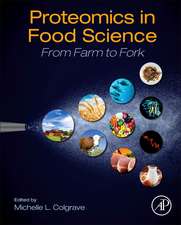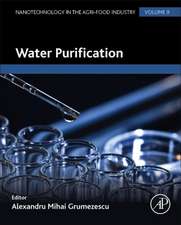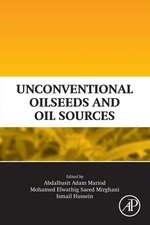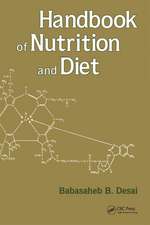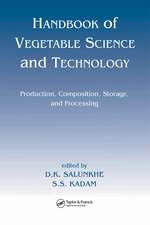Functional Foods and Biotechnology, Two Volume Set
Editat de Kalidas Shetty, Dipayan Sarkaren Limba Engleză Hardback – 15 apr 2020
Key Features:
- Provides ecological and metabolic rational to integrate novel functional food and functional ingredient sources in wider health-focused food system innovations.
- Examines the value-added role of select functional foods and food ingredients to improve NCD-linked health benefits such as type-2 diabetes, cardiovascular disease, and human gut improvement
- Provides system science-based food biotechnology innovations to design and advance functional foods and food ingredients for solutions to emerging global food and nutritional insecurity coupled public health challenges.
- Discusses biotransformation innovations to improve human health relevant nutritional qualities of functional foods and food ingredients.
Preț: 1016.72 lei
Preț vechi: 1346.35 lei
-24% Nou
Puncte Express: 1525
Preț estimativ în valută:
194.58€ • 202.39$ • 160.63£
194.58€ • 202.39$ • 160.63£
Carte tipărită la comandă
Livrare economică 15-29 aprilie
Preluare comenzi: 021 569.72.76
Specificații
ISBN-13: 9780367426361
ISBN-10: 0367426366
Pagini: 1056
Dimensiuni: 210 x 280 x 117 mm
Greutate: 2.11 kg
Ediția:1
Editura: CRC Press
Colecția CRC Press
ISBN-10: 0367426366
Pagini: 1056
Dimensiuni: 210 x 280 x 117 mm
Greutate: 2.11 kg
Ediția:1
Editura: CRC Press
Colecția CRC Press
Public țintă
Professional ReferenceCuprins
VOLUME I
Chapter 1 Introduction: Metabolic-Driven Ecological Rationale to Advance Biotechnological Approaches for Functional Foods
Chapter 2 Science Behind the Substantiation of Health Claims in Functional Foods: Current Regulations
SECTION 1 SOURCES OF FUNTIONAL FOODS AND INGREDIENTS
Chapter 3 Bioactive Ingredients from Corn and Lactic Acid Biotransformation
Chapter 4 Human Health Relevant Bioactive Functionalities of Ancient Emmer Wheat
Chapter 5 Functional Bioactives from Barley for Human Health Benefits
Chapter 6 Health Beneficial Functions of Black Soybean Polyphenols
Chapter 7 Bioprocessing Strategies to Enhance L-DOPA and Phenolic Bioactives in the Fava Bean (Vicia faba)
Chapter 8 Human Health Relevant Bioactives and Associated Functionalities of Herbs from Lamiaceae Family
Chapter 9 Lemnaceae: Source Food Supplements to Functional Foods
Chapter 10 Xylooligosaccharides and Their Functional Applications
Chapter 11 Biotechnology of Nonnutritive Sweeteners
Chapter 12 Carotenoprotein from Seafood Waste
VOLUME II
SECTION 1 BIOTRANSFORMATION OF FUNCTIONAL FOODS AND INGREDIENTS
Chapter 1 Metabolic Modulation of Abiotic Stress Response for Improvement of Functional Ingredients in Food Plants
Chapter 2 Biotransformation of Food-Related Phytochemicals by the Gut Bacteria
Chapter 3 Biotransformation of Tuber Crop Ingredients with Lactic Acid Bacteria-Focus on Functional Food and Disease Prevention
Chapter 4 Lactic Acid Fermentation and Bioactive Enrichment of Functional Ingredients in Berries
Chapter 5 New Innovations in Fermentation Biotechnology of Traditional Foods of the Indian Sub-Continent
Chapter 6 Fermentation Biotechnology of African Traditional Foods
Chapter 7 Improved Traditional Fermented Foods of the Mediterranean Region – Health Benefits as Functional Foods
Chapter 8 Tequila: Biotechnology of its Production
Chapter 9 Technologies for Microbial Production of Food Ingredients
Chapter 10 Biotechnology of Microbial Flavors
Chapter 11 Phospholipase D Inhibition by Hexanal, and its Applications in Enhancing Shelf Life and Quality of Fruits, Vegetables and Flowers
Chapter 12 Production and Recovery of Enzymes for Functional Food Processing
SECTION 2 ANALYSIS OF FUNCTIONAL FOODS AND INGREDIENTS
Chapter 15 Applications of Cell and Cell Based Models to Screen the Health Promoting Properties of Dietary Components
Chapter 16 Biological Functions and Health Benefits of Food Polyphenols
Chapter 17 Plant Phytochemicals for Cancer Chemoprevention: Applications and Advantages
Chapter 18 Beneficial Lactic Acid Bacteria (LAB) Based Biotransformation of Plant and Dairy Substrates to Enhance Type 2 Diabetes Relevant Health Benefits
Chapter 19 The Potential Roles and Implications of Microbiota on Maternal and Child Health
Chapter 20 Genetic Characterization of Antimicrobial Peptides
Chapter 21 Natural Antimicrobials from Plants for Food Applications
Chapter 22 Quorum Sensing Inhibitors from Phytochemicals and Food Sources and Their Potential Applications in Food Quality
Chapter 1 Introduction: Metabolic-Driven Ecological Rationale to Advance Biotechnological Approaches for Functional Foods
Chapter 2 Science Behind the Substantiation of Health Claims in Functional Foods: Current Regulations
SECTION 1 SOURCES OF FUNTIONAL FOODS AND INGREDIENTS
Chapter 3 Bioactive Ingredients from Corn and Lactic Acid Biotransformation
Chapter 4 Human Health Relevant Bioactive Functionalities of Ancient Emmer Wheat
Chapter 5 Functional Bioactives from Barley for Human Health Benefits
Chapter 6 Health Beneficial Functions of Black Soybean Polyphenols
Chapter 7 Bioprocessing Strategies to Enhance L-DOPA and Phenolic Bioactives in the Fava Bean (Vicia faba)
Chapter 8 Human Health Relevant Bioactives and Associated Functionalities of Herbs from Lamiaceae Family
Chapter 9 Lemnaceae: Source Food Supplements to Functional Foods
Chapter 10 Xylooligosaccharides and Their Functional Applications
Chapter 11 Biotechnology of Nonnutritive Sweeteners
Chapter 12 Carotenoprotein from Seafood Waste
VOLUME II
SECTION 1 BIOTRANSFORMATION OF FUNCTIONAL FOODS AND INGREDIENTS
Chapter 1 Metabolic Modulation of Abiotic Stress Response for Improvement of Functional Ingredients in Food Plants
Chapter 2 Biotransformation of Food-Related Phytochemicals by the Gut Bacteria
Chapter 3 Biotransformation of Tuber Crop Ingredients with Lactic Acid Bacteria-Focus on Functional Food and Disease Prevention
Chapter 4 Lactic Acid Fermentation and Bioactive Enrichment of Functional Ingredients in Berries
Chapter 5 New Innovations in Fermentation Biotechnology of Traditional Foods of the Indian Sub-Continent
Chapter 6 Fermentation Biotechnology of African Traditional Foods
Chapter 7 Improved Traditional Fermented Foods of the Mediterranean Region – Health Benefits as Functional Foods
Chapter 8 Tequila: Biotechnology of its Production
Chapter 9 Technologies for Microbial Production of Food Ingredients
Chapter 10 Biotechnology of Microbial Flavors
Chapter 11 Phospholipase D Inhibition by Hexanal, and its Applications in Enhancing Shelf Life and Quality of Fruits, Vegetables and Flowers
Chapter 12 Production and Recovery of Enzymes for Functional Food Processing
SECTION 2 ANALYSIS OF FUNCTIONAL FOODS AND INGREDIENTS
Chapter 15 Applications of Cell and Cell Based Models to Screen the Health Promoting Properties of Dietary Components
Chapter 16 Biological Functions and Health Benefits of Food Polyphenols
Chapter 17 Plant Phytochemicals for Cancer Chemoprevention: Applications and Advantages
Chapter 18 Beneficial Lactic Acid Bacteria (LAB) Based Biotransformation of Plant and Dairy Substrates to Enhance Type 2 Diabetes Relevant Health Benefits
Chapter 19 The Potential Roles and Implications of Microbiota on Maternal and Child Health
Chapter 20 Genetic Characterization of Antimicrobial Peptides
Chapter 21 Natural Antimicrobials from Plants for Food Applications
Chapter 22 Quorum Sensing Inhibitors from Phytochemicals and Food Sources and Their Potential Applications in Food Quality
Descriere
The two volume set of Functional Foods and Biotechnology illuminates the role of metabolic and biochemical processing in the improvement of functional foods with targeted health benefits and increased nutrient value.







